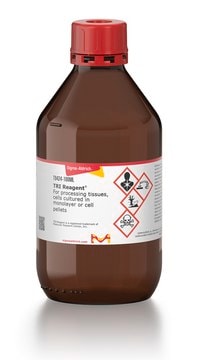496189
Cloroformo
biotech. grade, ≥99.8%, contains 0.5-1.0% ethanol as stabilizer
Sinónimos:
Triclorometano, Tricloruro de metilidino
About This Item
Productos recomendados
grado
biotech. grade
Nivel de calidad
densidad de vapor
4.1 (vs air)
presión de vapor
160 mmHg ( 20 °C)
Ensayo
≥99.8%
Formulario
liquid
contiene
0.5-1.0% ethanol as stabilizer
impurezas
<0.01% water
residuo de evap.
<0.0003%
color
APHA: ≤10
¿Está buscando productos similares? Visita Guía de comparación de productos
Descripción general
Aplicación
- Synthesis of colloidal hydrophobic CdSe core nanocrystals (quantum dots).[3]
- Preparing phospholipid solutions.[4]
- As a solvent in the photolysis reaction of ruthenium complexes.[5]
- Solvent for recrystallization.[6]
- Reference compound to detect the presence of chloroform in Tobacco smokes.[7]
- Extractant in solvent extraction process.[8]
Palabra de señalización
Danger
Frases de peligro
Clasificaciones de peligro
Acute Tox. 3 Inhalation - Acute Tox. 4 Oral - Carc. 2 - Eye Irrit. 2 - Repr. 2 - Skin Irrit. 2 - STOT RE 1 Oral - STOT SE 3
Órganos de actuación
Central nervous system, Liver,Kidney
Código de clase de almacenamiento
6.1D - Non-combustible acute toxic Cat.3 / toxic hazardous materials or hazardous materials causing chronic effects
Clase de riesgo para el agua (WGK)
WGK 3
Punto de inflamabilidad (°F)
does not flash
Punto de inflamabilidad (°C)
does not flash
Elija entre una de las versiones más recientes:
¿Ya tiene este producto?
Encuentre la documentación para los productos que ha comprado recientemente en la Biblioteca de documentos.
Los clientes también vieron
Nuestro equipo de científicos tiene experiencia en todas las áreas de investigación: Ciencias de la vida, Ciencia de los materiales, Síntesis química, Cromatografía, Analítica y muchas otras.
Póngase en contacto con el Servicio técnico





